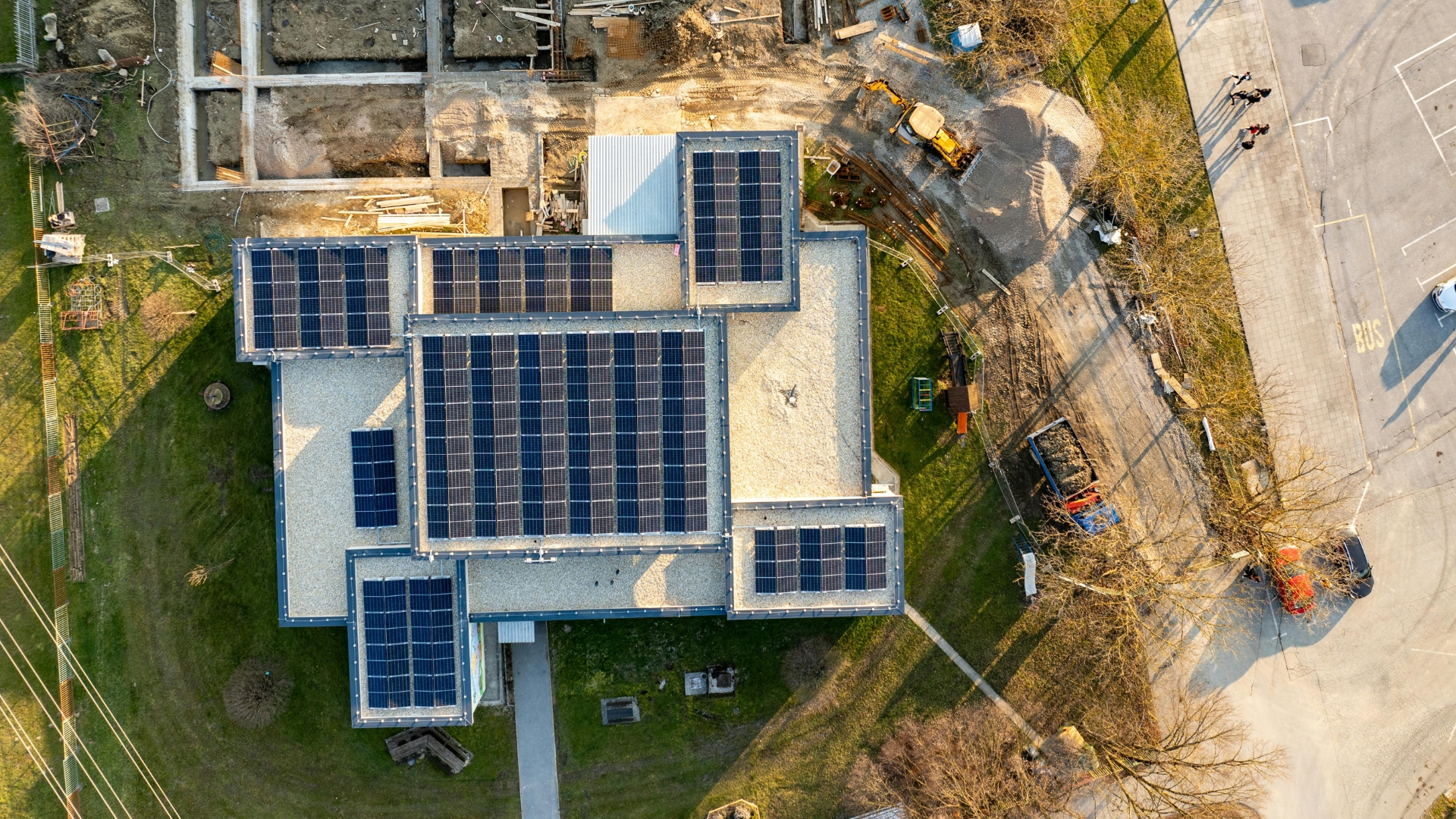August 11, 2025
In 2025, solar professionals are no longer using just one platform to manage solar projects. They’re combining multiple solar software tools to meet the demands of an increasingly competitive solar industry.
From solar design and proposal generation to CRM and project tracking, sales teams are crafting hybrid workflows that rely on specialized tools, such as Aurora Solar, Solargraf, and OpenSolar.
This flexible “stack” approach allows teams to hand-pick their favorite solar design software tools, but it also introduces friction, including login fatigue and inconsistent system outputs.
Aurora, Solargraf & OpenSolar: Tools Solar Teams Combine in 2025
When building stacks, constant management is essential; without it, a seamless workflow becomes a dream long gone.
A usual day looks like this: Design in Aurora. Quote in Solargraf. Pitch with OpenSolar. Repeat. It works, until it doesn't.
In this blog, we’ll break down how modern solar companies are stacking their tools, what each platform does best, and why the future might require more than just good software.
Key Takeaways
- Solar sales teams are combining tools like Aurora Solar, Solargraf, and OpenSolar to manage the entire sales process.
- This multi-tool approach gives access to the best solar design software, proposal systems, and CRMs, but leads to fragmented workflows.
- A lack of seamless integration leads to duplicate work, inconsistent system performance, and missed opportunities.
- The key to choosing the right tools is looking into how well they work together.
The Rise of Multi-Tool Solar Stacks
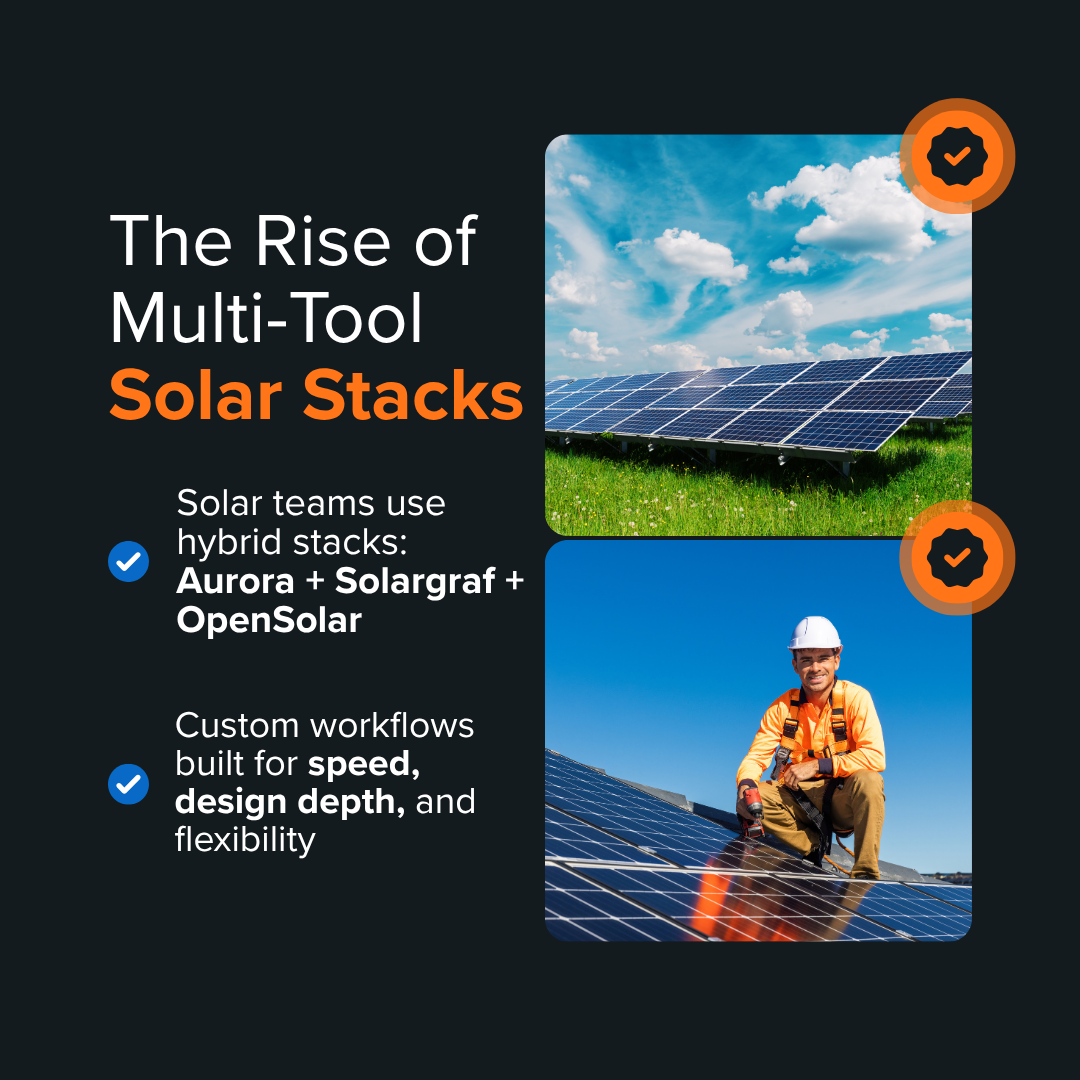
No two solar teams operate the same, and that’s exactly why the stack strategy exploded.
Some teams are hyperlocal- managing a few residential solar panel installations a week. Others run high-volume commercial solar operations across states. Therefore, each team requires different strengths, such as quick quoting, detailed PV system design, or meticulous project tracking.
That variety? It’s too much for one platform to handle well. So, teams started building their custom toolkits. One for 3D modeling, another for detailed shading analysis, maybe a spreadsheet or CRM on the side.
That’s how the modern installer tech stack was born, not out of preference, but out of necessity.
Aurora Solar: Deep Design + Financial Analysis
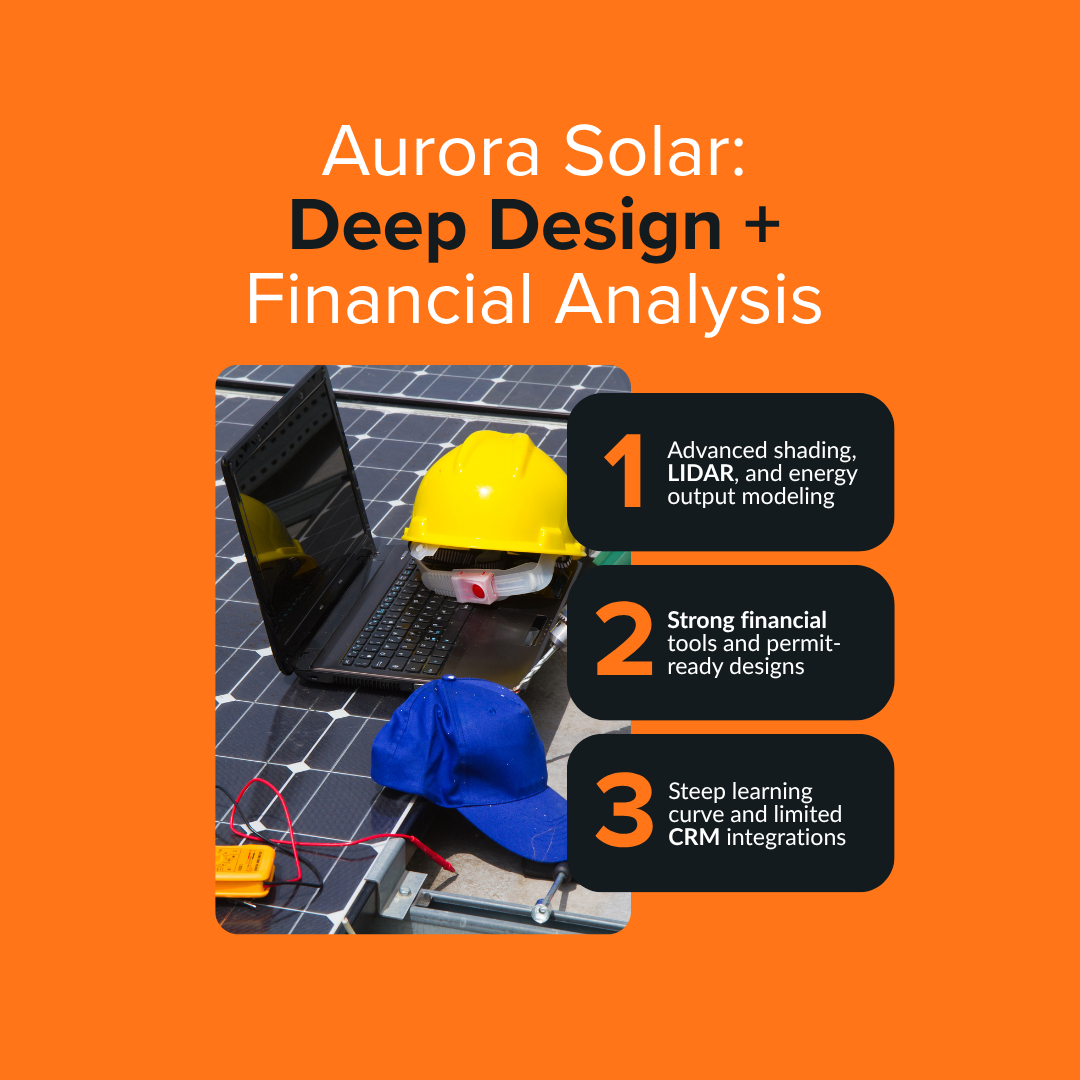
Out of all the tools in a solar stack, Aurora Solar usually handles the heavy lifting on design. It’s what teams turn to when they need to pinpoint accuracy, regulatory compliance, and reliable solar energy output projections.
Here’s how it fits in, where it excels, and why it’s often considered the technical backbone of a modern solar software stack.
A. The Problem It Solves
Most design tools stop at layouts, but solar teams need accurate solar designs, real-world performance estimates, and airtight financial analysis to close deals and make better solar power systems. Aurora helps solve
this exact issue.
It’s built for solar professionals who want more than drag-and-drop: precision, compliance, and bankable numbers.
B. What It Delivers
Aurora combines AI-assisted panel placement, advanced shading analysis, and high-resolution data layers, such as LIDAR and irradiance maps. The result? Efficient solar system designs that withstand both boardroom scrutiny and permitting.
It also provides teams with tools to run detailed energy output models and financing solutions, all on one platform.
C. Where It Shines
- Residential and commercial solar teams that prioritize design accuracy
- Installers working in cities with tough permit requirements
- Sales teams that want to back their quotes with bulletproof energy production estimates
Aurora is often called the best solar design software for a reason: it’s comprehensive, powerful, and highly respected in the solar industry.
D. Where It Struggles
- Steep learning curve, especially for new reps or non-technical users
- Requires a solid internet connection and newer hardware for a smooth design flow
- Limited out-of-the-box CRM system support, needs workarounds or third-party connections
- High pricing tiers may be a barrier for small or new solar businesses
Solargraf: Fast Site Surveys + Flexible Proposals (Now Part of Enphase)
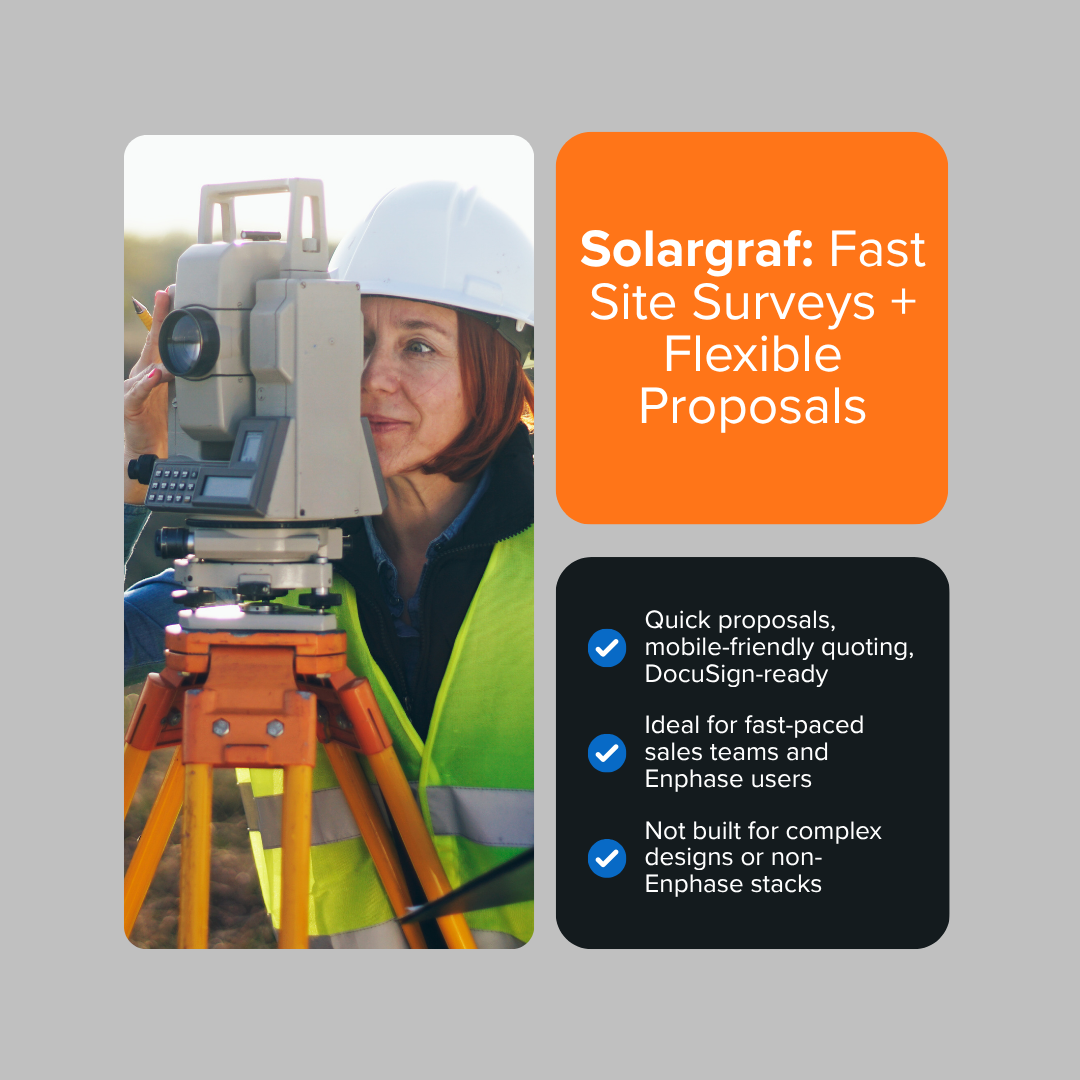
Not every project needs a deep-dive design. Sometimes, speed is what seals the deal, especially in high-volume sales or markets where turnaround time makes or breaks conversions.
That’s where Solargraf comes in: a lightweight, proposal-first platform that prioritizes velocity over complexity.
Note: Solargraf now operates under a different strategic direction, having been acquired by Enphase Energy, the parent company of Sofdesk, in January 2021.
A. The Problem It Solves
Many solar sales teams don’t need granular shading data; they need solar proposals that look good, get sent out quickly, and get signed.
Solargraf makes it easy to generate polished proposals in minutes, even on-site. It’s built for fast-moving reps who are more focused on closing deals than configuring them.
B. What It Delivers
Since the Enphase acquisition, Solargraf has significantly improved its capabilities. The platform now offers AI-powered 3D design tools with automatic obstruction detection, NREL-verified shading analysis, and seamless integration with DocuSign for electronic signatures.
You can upload images, add branding, and send contracts all within the platform. It also offers digital sales enablement tools and services for homeowner proposal generation, permitting, third-party financing, and post-sales support
It’s also one of the few tools that supports remote quoting for residential and commercial solar with minimal training.
C. Where It Shines
- Small to mid-sized solar businesses looking for plug-and-play simplicity
- Teams are prioritizing fast proposal generation over deep system design
- High-volume installers who want reps to close on-site
- Sales ops that need a sleek front-end without tech-heavy workflows
- Enphase Installer Network members who benefit from integrated digital platform capabilities
D. Where It Struggles
- Basic solar design software, not built for complex PV system design or advanced shading
- Limited value for utility-scale projects or teams needing precise modeling
- Proposals look great, but may lack the detailed financial analysis required by some lenders
- Integrations with CRM systems and other tools can feel limited
- Now operates within Enphase's broader strategic ecosystem, which may limit flexibility for non-Enphase hardware configurations
OpenSolar: Free Design + End-to-End Proposal System
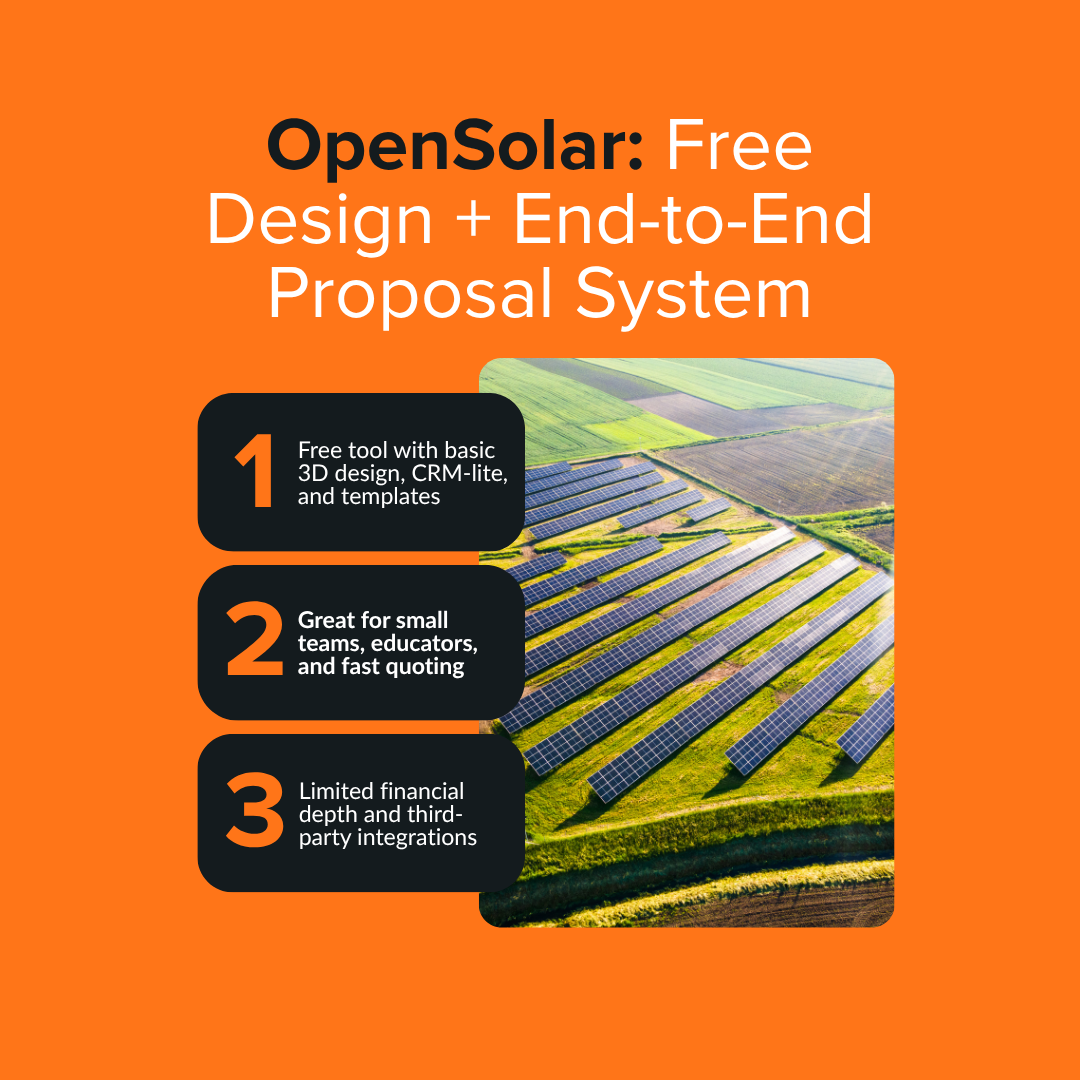
When budgets are tight or teams are just getting started, OpenSolar often becomes the default.
While the platform maintains its commitment to free core design tools, it has evolved beyond simple "free software" to offer a more comprehensive business model that includes both free and premium services.
A. The Problem It Solves
Many new or small solar companies don’t have the budget for premium platforms but still need reliable tools to generate proposals, design layouts, and manage the sales process.
OpenSolar makes that possible with its unique partner-funded model, where product manufacturers, finance companies, distributors, and other service providers fund the platform, keeping core tools free for solar professionals.
B. What It Delivers
At its core, OpenSolar offers cloud-based solar design software tools with basic 3D modeling, accurate system
layouts, and templated proposals. It also includes basic CRM features and some financing solutions, making it a genuine starter stack.
Recent platform updates include enhanced Bill of Materials (BOM) generation, automated customer emails with attached documents, and improved pricing engines with detailed component-level pricing.
The platform now features CashFlow payment system integration, as well as support for Apple Pay & Google Pay for instant payments, and automated permitting integration with SolarApp.
C. Where It Shines
- Ideal for new or budget-conscious solar installers
- Perfect for teams focused on residential and commercial solar quoting
- Great for companies that want to move quickly without investing in multiple platforms
- Good choice for educators, pilot projects, and clean energy solutions organizations
- Strong choice for teams seeking integrated finance solutions and automated workflows
D. Where It Struggles
- Limited depth in detailed financial analysis or complex system design
- Lacks robust tools for utility-scale projects or compliance-heavy zones
- Integrations with third-party CRM systems and solar monitoring systems are minimal
- Less suitable for teams needing high-end customization or deep shading analysis
- While design tools remain free, premium features and advanced integrations may require investment
What’s Missing When You Combine Tools?
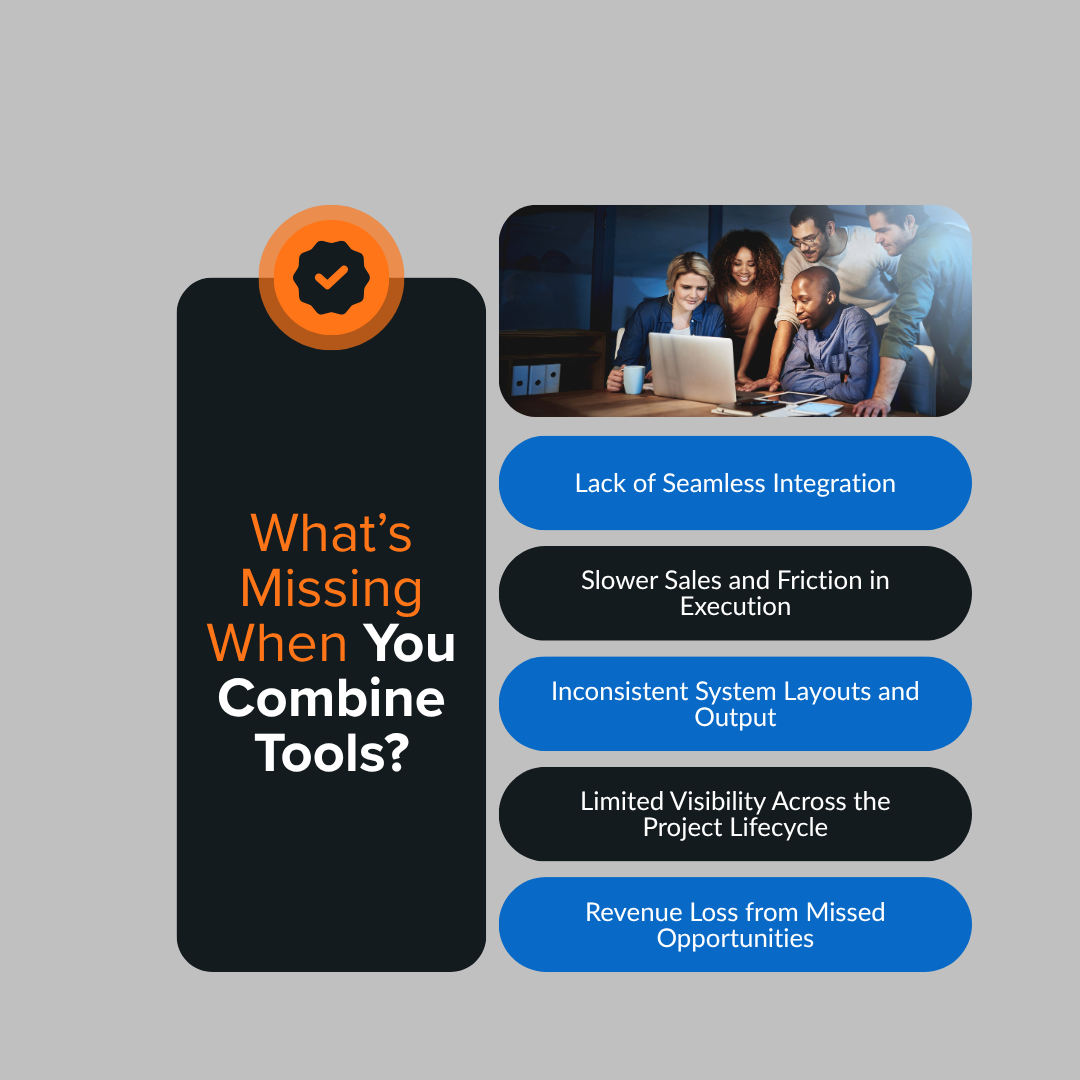
Even with top-tier platforms in the mix, solar teams often struggle with their workload. The problem isn’t always the tools; it’s how poorly they talk to each other.
Here’s what goes missing when you rely on a multi-tool solar stack:
1. Lack of Seamless Integration
Combining Aurora, Solargraf, and OpenSolar creates integration gaps. Teams often have to transfer data manually between tools, increasing the risk of errors.
Instead of a centralized workflow, they’re forced to jump between tabs, one for solar design, another for proposals, and a third for CRM tasks. This not only slows down operations but also impacts system consistency.
2. Slower Sales and Friction in Execution
Disconnected tools create friction at every stage of the sales process.
Reps waste valuable time switching tools, fixing formatting, and verifying client data across platforms. What should be a smooth sales handoff becomes a back-and-forth chase across systems.
This delay affects close rates, particularly in fast-paced residential and commercial solar markets.
3. Inconsistent System Layouts and Output
Each platform may use different modeling methods, which can lead to discrepancies in system layouts, energy output, and pricing calculations.
This inconsistency not only affects customer trust but also puts pressure on backend teams to cross-check proposals, designs, and site data.
4. Limited Visibility Across the Project Lifecycle
Without unified dashboards or synced records, tracking a deal from lead capture to solar installation becomes messy.
Important notes are often stored in emails or spreadsheets rather than a centralized CRM. This makes it difficult to follow up, manage installs, or review performance post-sale, especially for teams scaling quickly.
5. Revenue Loss from Missed Opportunities
Proposal delays, missing follow-ups, and data duplication can directly impact revenue. Without a tight system flow, upselling, cross-selling, and long-term client engagement become much harder.
For teams aiming to scale solar panel installations or expand into utility-scale projects, fragmented software is a significant challenge that hinders seamless growth.
Check out: Can Solar Software Double Your Sales During a Downturn?
Key Features Sales Teams Actually Need

Most solar software platforms focus on design, but solar sales teams need more than clean system layouts or 3D visuals.
To move deals forward, reps need tools that streamline the entire customer journey, from first interaction to final install. Here’s what today’s top-performing solar sales teams actually look for.
1. Fast, Customizable Proposal Generation
Speed matters. Teams want to generate branded, accurate proposals in minutes, not hours.
The ideal tool should allow for easy customization, digital signatures, and flexible pricing based on geography or financing type. Platforms like Solargraf handle this well, but many design-first tools fall short.
2. Integrated Financial Analysis
Buyers today want more than just visuals; they want numbers that make sense.
Solar tools need built-in financial analysis capabilities that help reps present loans, rebates, and savings estimates clearly. Without this, reps are forced to rely on spreadsheets or third-party calculators, adding more steps to the sales process.
3. CRM and Lead Tracking Integration
Reps shouldn’t be toggling between five tabs to find a lead’s contact info.
Software that integrates seamlessly with CRM systems helps teams log notes, track communication, and automate follow-ups. Without this software, deals fall through the cracks and teams lose valuable time.
4. Real-Time Design Tools
Instant layout previews, AI-assisted panel placement, and 3D modeling features help reps explain designs to customers on the spot.
This boosts transparency and confidence, especially in competitive residential markets where solar professionals are fighting for attention.
5. Mobile-Friendly, On-Site Functionality
Sales don’t happen behind a desk. Reps need access to solar proposal tools, customer info, and design previews from a tablet or phone.
This is especially important for teams doing in-person site visits or managing large volumes of solar panel installations.
6. Seamless Handoff to Ops and Install Teams
Once a deal is signed, the information needs to flow directly to the install or engineering team, with no manual rework.
When you are dealing with commercial solar, small-scale rooftops, or full energy solar systems, sales tools need to support downstream execution through accurate data and shared dashboards.
Check out: How Solar CRM Software Can Help You Win More Projects
Designing the Ideal Solar Software Stack
There’s no universal blueprint, but the best solar software stacks in 2025 are built with intention. High-performing teams are asking one key question: Does this tool reduce friction or create it?
Here’s what an effective, modern solar stack tends to include, and what makes it work.
1. Design That Balances Speed and Accuracy
Top stacks use design tools that combine AI-assisted panel placement, accurate system layouts, and realistic energy output modeling.
Whether it's Aurora’s precision or OpenSolar’s simplicity, the design layer has to match the team’s technical demands without slowing them down.
2. Proposal Tools That Support Scale
A winning stack includes flexible, fast proposal software, ideally with built-in pricing, contract generation, and branded templates.
If reps need to export data or redo designs to generate proposals manually, the stack isn’t working hard enough. Moreover, platforms like Solargraf shine in this layer, especially for residential and commercial solar sales.
Also read: Streamline Solar Proposals with Sunbase for Faster Conversions to see why fast, flexible quoting tools give sales teams a competitive edge.
3. Integrated CRM and Project Visibility
Teams need a system that enables seamless lead capture, contact management, and project tracking.
Stacks that connect CRM, proposal, and design data in one view give teams complete visibility across the entire sales process, from first call to install.
4. Flexibility to Handle Diverse Project Types
Whether you’re managing utility-scale projects, suburban installs, or battery-backed PV system designs, the stack should adapt.
That means supporting both simple quotes and complex system design, with adjustable workflows for engineers,
sales reps, and ops teams.
5. Unified Data = System Efficiency
When every tool feeds into a central source of truth, you avoid rework, cut delays, and improve system efficiency.
The ideal stack reduces the need for double entry, ensures clean handoffs, and gives leadership real-time insights across the business.
Where the Industry Is Headed: Consolidation or Customization?

As the solar software space matures, teams are facing a crossroads: stick with a flexible, multi-tool setup, or consolidate into a unified platform.
Both paths have trade-offs, but industry trends point to one clear direction: consolidation is coming.
1. The Custom Stack Worked Until It Didn’t
For the past few years, building a custom solar stack has given teams freedom. You could combine your favorite solar design software, CRM system, proposal tool, and project tracking app into a workflow tailored to your needs.
But with every added tool, the cracks widened: syncing issues, version mismatches, and data silos started slowing things down. What began as a smart workaround now feels like a bottleneck.
2. Platforms Are Racing Toward All-in-One
Newer solar software solutions are prioritizing vertical integration. They’re building end-to-end systems that manage everything, from initial design to solar installation, payment, and post-sale monitoring.
Why? Because the market is demanding it.
Sales teams, ops managers, and solar developers are tired of jumping across systems. They want clean workflows, shared dashboards, and reliable performance.
3. Specialized Tools Still Have a Role
Even as consolidation grows, best-in-class tools like Aurora or Solargraf won’t disappear. In fact, they may evolve
to serve as premium integrations within larger platforms or focus on niche areas like advanced shading analysis or utility-scale project design.
The key is how well these tools enable solar professionals to connect, adapt, and deliver.
4. Future-Ready Teams Are Already Simplifying
Forward-thinking solar companies aren’t waiting for the perfect tool; they’re proactively streamlining. That means:
- Reducing tool count
- Auditing workflows
- Focusing on clean data flow and user adoption
- Prioritizing platforms with demonstrated acquisition strategies and ecosystem development
This is where tools like Sunbase are leading the way by blending solar design, sales workflows, and CRM into a single, integrated solution.
The future of solar isn’t about collecting tools. It’s about creating a system that works.
Conclusion: The Trade-Off Between Power and Simplicity
Solar teams in 2025 have more tools than ever before, and that’s both a blessing and a burden.
You can stack Aurora for precision, Solargraf for speed, and OpenSolar for flexibility. However, the truth is that even the best solar software tools of 2025 cannot deliver full value if they’re not working together.
Each extra platform adds complexity: another login, another data source, another potential point of failure.
That’s the trade-off. Powerful tools give you control, but simplicity gives you momentum. As solar teams scale, the goal isn’t just having the most features.
It’s building a system that reduces friction, maximizes energy yields, and keeps your team focused on what matters: closing deals, installing fast, and delivering high-performing solar power systems.
About Sunbase
Sunbase unifies design, proposals, CRM, and install ops, all in one dashboard. So, if your solar stack feels like it’s holding you back, it might be time to simplify.
Book your demo today and experience the momentum you gain when everything comes together.
FAQs
1. Why do solar teams use multiple software tools instead of one?
Most solar software platforms specialize in one area, like design, proposals, or CRM, but don’t cover the entire sales cycle. To meet their operational needs, solar teams combine tools to create a custom stack that fits their workflow.
2. What are the downsides of using multiple solar software tools?
While multi-tool stacks offer flexibility, they often lead to duplicate data entry, poor integration, inconsistent system layouts, and slower turnaround times, all of which can hurt performance and sales efficiency.
3. Is there an all-in-one alternative to stacking solar software?
Yes. Platforms like Sunbase aim to eliminate tool fragmentation by offering solar design, proposals, CRM, and project tracking in one integrated solution. This reduces friction and streamlines the entire sales process.
I agree to receive marketing messaging from Sunbase at the phone number provided above. I understand data rates will apply, and can reply STOP to OPT OUT.




